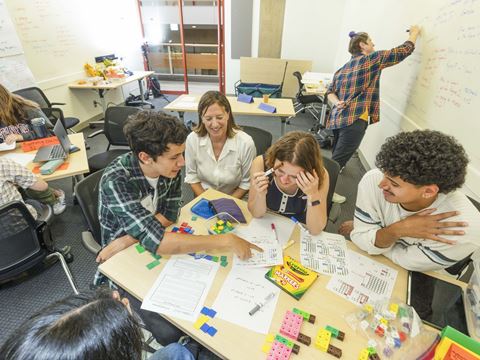
Geopolitics of a Textile
History
Southeast Asia
Written by Julie Weiss
How much do you think about what you read? When you read a news story, do you pause to mull over what it meant, or how it connects to something you know or have already encountered online? In the following activities, you'll read an article from AramcoWorld and then, with guidance, think about it more deeply.
We encourage reproduction and adaptation of these ideas, freely and without further permission from AramcoWorld, by teachers and students at any level.
—The Editors
Each lesson is based on one article: Here, we draw from "Our Story of Dhaka Muslin." The lessons include an introduction, a statement of goals—what students should be able to do by the time they finish—and step-by-step instructions for the activities. Each lesson also includes the Common Core standards that the lesson meets. We hope this format makes it easier than ever to use AramcoWorld for learning. Let us know! Send me your comments at [email protected].
—Julie Weiss
“Our Story of Dhaka Muslin”
How much do you think about what you read? When you read a news story, do you pause to mull over what it meant, or how it connects to something you know or have already encountered online? In the following activities, you'll read an article from AramcoWorld and then, with guidance, think about it more deeply. You'll find that the guidelines we present in this activity can be used with other resources, whether read for school or seen on the news, or taken from personal experience. By the time you finish the lesson, you will be able to successfully do the following:
- Summarize the history of muslin.
- Analyze the story, "Our Story of Dhaka Muslin," from geographic, economic and political perspectives.
- Apply what you've learned by using those perspectives to analyze something else.

1. Reading and Understanding
Read "Our Story of Dhaka Muslin," by Khademul Islam. As you read, use whatever methods work for you to focus your attention on and help you remember the important parts of the article. You can underline or highlight, or make notes in the margins or on paper or computer. Circle any words you come across that you may not know. Try to figure out what these words mean based on the context from the other words and sentences around them. If you can't figure out the meaning that way, look up the words.
When you're done, write a few sentences that summarize the article. Then write a few more sentences stating what you found most interesting in it, and why you found it so. Pair up with another student. Share what you've written with each other. Are your summaries similar? Have you both identified the key points the article makes. If not, discuss the differences and see if either or both of you need to revise or add to you've already jotted down. Then, determine if each other's points provide interesting insight. If not, discuss further ways to improve on your thoughts.
2. Preparing to Analyze
Once you understand the basic story of muslin, you can begin to thing about it more deeply. First, prepare a word web on chart paper. In the center, create a circle with the words, "The History of Dhaka Muslin," in it. For each section of the story, make a circle that radiates out from the center circle and follow the instructions to fill it in. You can do the following activities on your own, with a partner or as part of a small group.
3. Geographic Analysis

One curious point that the author makes is that the cotton plants used to make Dhaka muslin do not grow anyplace else. That means there must have been something quite unique about the area where the plants did grow. What was it about the place that made it ideal for growing the cotton plants, phuti karpa? Hint: Think about what it was near (in geographers' terms, its location and what the climate was like). In the geography circle of your word web, write what it was about Dhaka's location and climate that led to muslin being made there. What else about the geography enabled such spectacular muslin to be produce there? Hint: Think about the people—their skills and way of life. Add these also in the "Geography" circle.
4. Political Analysis
Label another circle "Politics." You'll fill it in by answering the questions that follow. Dhaka muslin became entangled in the politics that surrounded its production and distribution. Think about politics as being both political and, more broadly, about power. Find the parts of the article that address politics. Here are a few questions to get you started. How did Mughal leaders use muslin, and what did muslin signify to them? How did the British Empire affect the rise and fall of Dhaka muslin? Use your answers to these questions to fill in the “Politics” circle of your web.
5. Economic Analysis
Label another circle on your web “Economics.” Dhaka muslin became a valuable commodity on the Indian subcontinent, in China, on the Arabian peninsula and, eventually, in Western Europe. Find the parts of the article that refer to the buying and selling of muslin, including the discussion of trade and industrialization. You’ll probably notice that the economic factors sometimes overlap with the geographic and political factors. That’s OK—the world doesn’t organize itself neatly into academic disciplines, and so your web may well reflect that.
6. Bringing it Together
Now you’ve analyzed the history of Dhaka muslin from geographic, political, and economic perspectives. Study your graphic organizer. Use it as an outline to write an essay that has this thesis: The history of Dhaka muslin was shaped by geographic, political, and economic factors.
7. Using What You’ve Learned
A true test of how well you understand something is whether you can use what you’ve learned in a different context. Try it out. Make another web with the same three circles—geography, politics, and economics—coming out from the center. Choose a topic to analyze. It can be something you’ve studied in a history class or something that’s been in the news. For example, you could write “French Revolution” in the central circle and analyze it. Or you could write “Netflix” in the center and analyze the geographic, political, and economic factors that have contributed to its success. These are just a couple of ideas. Choose whatever topic you’d like and complete the web.
Common Core Standards met in this lesson:
RI.9-10.2 Determine a central idea of a text and analyze its development over the course of the text, including how it emerges and is shaped and refined by specific details; provide an objective summary of the text.
RI.9-10.4 Determine the meaning of words and phrases as they are used in a text, including figurative, connotative, and technical meanings; analyze the cumulative impact of specific word choices on meaning and tone (e.g., how the language of a court opinion differs from that of a newspaper).
Other lessons

How Art Connects
For the Teacher's Desk
Art links everything—cultures, history, even math. Want to hook students? Try teaching through the art that surrounds us with these stories.
Teaching Empathy: Five Classroom Activities From AramcoWorld
For the Teacher's Desk
Help students build empathy and community for the academic year with AramcoWorld’s stories and Learning Center lessons.
How To Improve Student Confidence Through Seeing Math Differently
For the Teacher's Desk
Hands-on activities shift math from memorization to exploration—building confidence and curiosity in the classroom.